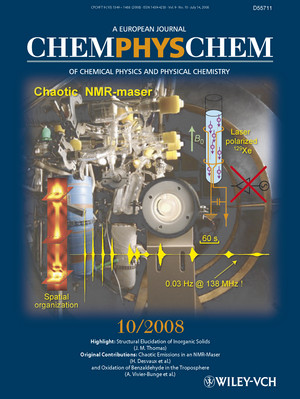 Authors: D.J. Marion, G. Huber, P. Berthault, H. Desvaux
Authors: D.J. Marion, G. Huber, P. Berthault, H. Desvaux
Liquid-state NMR is a very powerful method for chemical analysis but it suffers from inherent low sensitivity due to the weak involved energies, which leads to small thermal equilibrium polarization. A solution consists in resorting to transiently polarized nuclear spin systems such as those prepared by optical pumping or dynamic nuclear polarization. Nevertheless, the direct extension of the whole liquid-state NMR techniques to these systems might be less straightforward than anticipated. Indeed their nuclear magnetization can easily be on the same order of magnitude or much larger than that of bulk water in high field. For such high magnetization levels, the usual framework of NMR fails to describe the collective spin dynamics which appears [1]. It originates from the non-linear coupling between the magnetization and the detecting coil (radiation damping) and from the massive long distance dipolar couplings between the nuclear spins.
In this field, we have observed and characterized a new and unexpected phenomenon. The magnetization of dissolved hyperpolarized 129Xe is first prepared in its unstable state (negative xenon spin temperature) by the optical pumping process. When put in the high field NMR magnet, without rf excitation, the system spontaneously emits a series of rf bursts instead of one, as expected by the usual theory of radiation damping. We have experimentally shown that this also induces inhomogeneous spatial organization of the 129Xe magnetization. Even if it appears possible, by numerical simulations, to reproduce one emission leading to inhomogeneous spatial magnetization, a series seems to be impossible to obtain in the framework of a classical dipolar field. We have been able to prove that these multiple maser emissions are triggered by noise but the origin of the chaos remains unclear. Even if many elements indicate the main influence of long distance dipolar fields, in particular through the appearance of frequency beats or of very narrow lines, the chaos might also be due to the non-linearity of the Bloch-Maxwell equations as in chaotic laser at quasi-optical wave lengths. A practical technical consequence of this research was the finding of a new tuning approach which allows an increase of NMR sensitivity valid for any nuclear spin system [3].
This work is supported by the French Ministry of research, ANR "Programme blanc" : DIPOL - RMN non-linéaire dans les liquides polarisés / Non-linear NMR in polarised liquids).
- J. Jeener, in Encyclopedia of NMR, 9 (Eds.: D. M. Grant, R. K. Harris), Wiley, (2002), pp. 642-679.
- D. J. Marion, G. Huber, P. Berthault, H. Desvaux, ChemPhysChem, 9, 1395-1401 (2008).
- D. J. Marion, H. Desvaux, J. Magn. Reson., 193, 153-157 (2008).











